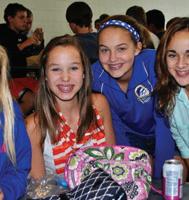










































2023-2024






















































































































































































































































































We are more connected now than ever – locally in our communities, across the nation and around the world. And with this connectivity comes the need for an understanding of different cultures and skills and strategies to navigate the global landscape.
This is why the Mariemont City School District established a Global and Cultural Perspectives Committee in 2015. This committee comprised of staff, parents and community members established our vision to value the dignity of all persons with the aim to increase knowledge and understanding of global and cultural perspectives throughout our school district.
Today, we remain committed to this vision and to creating a school culture that is purposeful and safe, promotes positive relationships, provides a well-rounded educational experience and encourages students to be global learners and deeply-committed members of the community and world.
In the pages that follow, you will develop a better understanding of our work and how we integrate global and cultural perspectives into the educational experience of our students that is grounded both in this vision to value the dignity of all persons and in Destination 2026, the strategic plan of the school district.
I would like to thank the teachers, parents and community members who offered their input in the development of this comprehensive guide. As you read, I hope you share in my excitement for Warriors BEglobal and the work we have embraced to prepare our Mariemont students to compete not just locally, but on the national and international stage.
Steven Estepp Superintendent, Mariemont City Schools
Superintendent’s Planning & Advisory Committee
District Global & Cultural Perspective Committee
Global & Cultural Perspective Community Taskforce
The Mariemont City School District Warriors BEglobal guide is a living document that focuses on the instructional impact, needs, beliefs and processes surrounding the integration of global & cultural perspectives in our classrooms and beyond. This guide serves as a resource for staff, parents and community members to better understand this work and its intent.
The Warriors BEglobal guide was developed in partnership with the District Global & Cultural Perspective Committee, Superintendent’s Planning & Advisory Committee and the Global & Cultural Perspective Community Taskforce.
These three groups, comprised of parents, staff, community members and a Board of Education representative reviewed current practices, philosophies and research to develop the guide.
Superintendent’s Planning & Advisory Committee, District Global & Cultural Perspective Committee and Global & Cultural Perspective Community Taskforce reviewed and discussed the competencies and outcomes to integrate global and cultural perspectives in Mariemont City Schools. All three groups brought unique perspectives into the development of this work.
A collaboration of parents, community members, staff, and the Board of Education.
A commitment to research and best practices to ensure the needs of students are met to increase their knowledge and understanding of global and cultural perspectives.















Today’s students are growing up in a diverse and global landscape. As a result, they need the knowledge, skills and strategies to interact and work with people of all backgrounds and cultures.
Additionally, today’s global society, sparked by rapid technological advances and innovation, is putting new demands on America’s workforce. Students must possess new skills and knowledge to be successful in the future.
So, what does this mean for the Mariemont City School District? How do we prepare children in Mariemont for their futures that will likely look very different from today?
Instruction must be more intentional and purposeful than ever before. Schooling can no longer be looked at as an event; rather it must become an experience in which students are deeply engaged, find passion, and experience practice in their learning.
Students must think critically and creatively across disciplines, and use technology to amplify their learning. They must collaborate to problem solve and develop skills to understand the global landscape.
In response to these ever-changing needs and demands, the Mariemont City School District launched Destination 2026 in 2014, the strategic plan to guide the instructional vision of the district, to explore the knowledge, skills and experiences students will need to compete globally and succeed consistently in tomorrow’s world.
• Student learning will be enhanced through diverse curricular options and enriching experiences that drive deeper understanding and skill development and support global competency.
• Student learning will be maximized through the creation of purposeful, safe physical and virtual learning environments for students and staff that promote communication and collaboration.
• Student learning will be enhanced through instruction and programming that are responsive to assessment results, designed to meet the individual needs of students and cultivate drive and resiliency.
• Student learning will be maximized through the implementation of innovative instructional practices that stimulate student interests and foster inspiration and passion.
Student success will increase through rigorous curriculum design, instructional best practices, meaningful programming and purposeful environments that maximize learner autonomy and capacity to thrive.
Today’s world is diverse and global.
Children and youth today need to be prepared to enter a college environment, workforce and adult society that spans across borders and involves interacting with people of varying abilities, unique life experiences, diverse backgrounds and perspectives in a myriad of settings. Furthermore, students must recognize the impact of these shifting demographics, abilities and financial realities. This evolving landscape necessitates a heightened awareness and adeptness in cultivating empathy, navigating differences and a genuine curiosity to learn from the stories and perspectives of others.
The United States has always had an ethnically diverse population, but in recent years, our country has undergone dramatic shifts creating a changing landscape. The United States Census Bureau estimates that by 2043, the U.S. will become a “majority minority” country. This means that although the non-Hispanic white population will remain, a single group will no longer make up the majority. More than 50 percent of the population will identify as belonging to an ethnic minority group or any group other than non-Hispanic white. The changing landscape also extends beyond ethnicity and includes significant variations in abilities and financial situations. According to the World Bank, approximately 15% of the global population lives with some form of disability.
Additionally, technology has made interactions across cultures around the world a very common experience. Social networking sites and video conferencing platforms are letting people regularly interact across national borders. Many industries currently have a significant amount of international collaboration, and careers in many fields increasingly involve working across
cultures, requiring language skills, regional knowledge and the ability to see things from different perspectives.
In a survey of 2,100 U.S. employers, 93 percent of respondents said they value employees who can work effectively with customers, clients and businesses from a range of different countries and cultures.
Recognizing the significance of these evolving demographics and abilities, many industries and professional organizations are emphasizing the importance of global and cultural perspectives and related skills (e.g., global awareness, emotional intelligence) as essential to prepare students for the world they will live in today and tomorrow.
Today’s students need to be equipped with critical thinking, communication, collaboration and language skills in order to work and live with their counterparts in the United States and around the world. Understanding and appreciating our diverse country and other parts of the world, including different religions, cultures, beliefs, abilities and perspectives will be essential.
These competencies are not isolated skills, but rather interrelated skills and areas of knowledge that are used together to enable individuals to understand and navigate a society and world that will only continue to become more diverse.
Recognize, understand and respect the cultures, perspectives, behaviors and beliefs of others and how they are similar and different from one self.
Acknowledge, appreciate and reflect on the importance of one’s own lived experiences and understand how perspectives, behaviors and actions impact others.
Build knowledge and continuously grow in awareness and understanding of cultures, perspectives and beliefs of others through reflection and a variety of experiences.
Seek opportunities to learn about and experience culturally diverse situations and engage with the greater community and world to make a positive impact.
The Mariemont City School District recognizes that, in order for this work to be purposeful, it must be intentional. There is also the need to clearly define the meaning and intent of the terms, skills and strategies that are used in the school district and what they look and sound like in classrooms. The global & cultural perspectives guide provides this clarity and ensures students develop a comprehensive understanding and a multitude of perspectives as they progress grade level by grade level and ultimately step into the context of the broader world upon graduation.
The global & cultural perspectives guide is comprised of three major components.
1
The framework frames the overarching global & cultural perspectives’ guiding principles and competencies for students, teachers, school and district leaders, families and community members.
2
3
Global & cultural perspectives’ competencies and outcomes are clearly defined by grade level bands (K-2, 3-5, 6-8, 9-12).
The glossary of terms defines the meanings and intent of the terms, skills and strategies that are used in the school district as part of the global & cultural perspectives framework, competencies and outcomes.
Began development of Destination 2026 to provide a vision for preparing our students to be future ready and developed Highly Effective Teaching and Highly Engaged Student Characteristics as the desired outcomes for our work.
District Global and Cultural Perspectives Committee was formed with 2 HS student leaders, staff representation from each of the 4 buildings, 5 community members, a building administrator, a board member and the superintendent. The committee was developed to work collaboratively on analyzing the district’s strengths and areas of opportunity in terms of global competencies and cultural proficiency. Warriors BEyond program launched. Day of Service implemented at MJHS. Expansion of international travel opportunities at MHS.
Developed the capacity of staff using the Cultural Proficiency Continuum to bridge gaps and improve student engagement.
Cultural Intelligence Leadership pilot involving the administrative team, district Global and Cultural Perspectives Committee Members and added parent representatives. Held student and staff focus groups and continued staff development on components of cultural intelligence. Began exploring more diverse books for K-12. Began purchasing classroom sets of school supplies K-6 to promote equity.
Compiled Equity Audit results and reviewed data. Continued cultural intelligence staff development. Development and implementation of two courses: 7th grade Cultural Intelligence (required) and 9-12 Human Experience and Cultural Intelligence (elective).
Began Global leadership Summit opportunity and 8th grade Washington, D.C. trip. Warriors Change the World begins at ME and TPE.
Established administrative guidelines for ensuring that religious and traditional holidays are respected, represented and/or celebrated in our musical programs and concerts. Began to build an understanding with the district committee of Global Competencies and Practices through the introduction of the Cultural Proficiency Continuum.
Implemented rollout of ipads as a common device for all students to promote equity.
Established building level Global and Cultural Perspective committees led by the district committee representatives. Further developed staff to understand the four tools of culturally proficient practices. These tools are interrelated and involve knowing the barriers to cultural proficiency, the guiding principles of cultural proficiency, the essential elements of cultural competence and the cultural proficiency continuum.
Incorporated more diverse book selections into classrooms. Began all elementary quarterly book reads. Named a Director of Equity and Inclusion. Staff development on fostering civil discourse, culturally proficient practices & cultural intelligence. Created Student Voices student leadership groups grades 5-12 in all buildings. Added a Global & Cultural Perspectives webpage to the district’s website as a central place for parents and community members to learn about the district’s work in this area. Began Equity Audit.
Three frameworks are commonly used to guide global & cultural perspectives work in schools, organizations and businesses. As part of the district’s work to establish its own, unique framework, these three research-based frameworks were carefully reviewed and analyzed.
Being aware of your own cultural beliefs and values and how these may be different from other cultures—including being able to learn about and honor the different cultures of those you work with. (source: Boix Mansilla, V.B. & Jackson A. (2011). Educating for global competence: Preparing our youth to engage the world. New York: Asia Society.)
VALUING DIVERSITY.
Accepting and respecting differences—different cultural backgrounds and customs, different ways of communicating and different traditions and values.
KNOWLEDGE OF STUDENTS' CULTURE.
Educators must have some base knowledge of their students' culture so that student behaviors can be understood in their proper cultural context.
BEING CULTURALLY SELF-AWARE.
Culture – the sum total of an individual's experiences, knowledge, skills, beliefs, values and interest – shapes educators' sense of who they are and where they fit in their family, school, community and society.
INSTITUTIONALIZING CULTURAL KNOWLEDGE AND ADAPTING TO DIVERSITY.
Culturally competent educators and the institutions they work in, can take a step further by institutionalizing cultural knowledge so they can adapt to diversity and better serve diverse populations.
DYNAMICS OF DIFFERENCE. Knowing what can go wrong in cross-cultural communication and how to respond to these situations.
2. Global Competence Framework: The capacity to recognize perspectives (others’ and one’s own) and to communicate ideas effectively across diverse audiences. (source: Boix Mansilla, V.B. & Jackson A. (2011). Educating for global competence: Preparing our youth to engage the world. New York: Asia Society.)
Identify an issue, generate questions, and explain its significance.
Use a variety of languages, sources, and media to identify and weigh relevant evidence.
Analyze, integrate, and synthesize evidence to contruct coherent responses.
Develop an argument based on compelling evidence that draws defensible conclusions.
Students investigate the world beyond their immediate environment.
Students recognize their own and others’ perspectives.
Identify and create opportunities for personal or collaborative action to improve conditions.
Assess options and plan actions based on evidence and potential for impact.
Act personally or collaboratively in creative and ethical waysto contribute to improvement, and assess the impact of actions taken.
Reflect on capacity to advocate for and contribute to improvement.
Students translate their ideas into appropriate actions to improve conditions.
Students communicate their ideas effectively with diverse audiences.
Recognize and express one’s own perspective, and identify influences on that perspective.
Examine others’ perspectives, and identify what influenced them.
Explain the impact of cultural interactions.
Articulate how differential access to knowledge, technology, and resources affects quality of life and perspectives.
Recognize and express how diverse audiences perceive meaning and how that affects communication.
Listen to and communicate effectively with diverse people.
Select and use appropriate technology and media to communicate with diverse audiences.
Reflect on how effective communication affects understanding and collaboration in an interdependent world.
3. Cultural Intelligence Framework: The skill to relate and work effectively in culturally diverse situations. (source: Livermore, D. (2015). Leading with Cultural Intelligence. New York: American Management Association.)
BEHAVIORAL
Changing verbal and nonverbal actions appropriately when interacting cross-culturally
MOTIVATION
Having the interest, confidence, and drive to adapt cross-culturally
METACOGNITION
Making sense of culturally diverse experiences and planning accordingly
COGNITION
Understanding intercultural norms and differences: communication styles, religous beliefs, gender roles, business systems, political systems
Recognize, understand and respect the cultures, perspectives, behaviors and beliefs of others and how they are similar and different from one self.
The Mariemont City Schools’ Global and Cultural Perspectives Framework was uniquely designed for our district, drawing on commonly used research-based frameworks (global competence, cultural competence and cultural intelligence) and feedback from district stakeholders and community members. This framework serves as the springboard for the development of specific grade band outcomes and is intended for use across all teaching and learning environments.
Acknowledge, appreciate and reflect on the importance of one’s own lived experiences and understand how perspectives, behaviors and actions impact others.
Build knowledge and continuously grow in awareness and understanding of cultures, perspectives and beliefs of others through reflection and a variety of experiences.
Seek opportunities to learn about and experience culturally diverse situations and engage with the greater community and world to make a positive impact.
Recognize, understand and respect the cultures, perspectives, behaviors and beliefs of others and how they are similar and/or different from oneself.
K-23-56-89-12
R1. Recognize that each family may be similar to and different from others.
R1. Recognize that each family’s behavior and beliefs may be similar to and different from those of other individuals and communities.
R1. Recognize and understand the similarities and differences between families and cultures.
R2. Recognize that you are unique but that you have similarities to and differences from others.
R3. Recognize that everyone has their own feelings and emotions.
R2. Articulate similarities to and differences from others and embrace your uniqueness.
R2. Engage respectfully with others who share similarities and differences and share your uniqueness.
R1. Recognize and understand the similarities and differences between one’s family culture and other family cultures and how to maintain individuality in these diverse environments.
R2. Respect yourself and interact with others respectfully, regardless of similarities and differences.
R4. Recognize what empathy is and how it helps to understand others.
R3. Understand, articulate and respect others’ feelings and emotions.
R4. Distinguish between empathic and non-empathic responses in various situations and comprehend how it affects others.
R3. Form relationships and build connections with others by exhibiting empathy, respect, and understanding towards others, regardless of similarities or differences.
R3. Hold connections with others in high regard and build rapport and establish relationships with individuals, despite differences or conflicting opinions.
R5. Recognize the interests, qualities, and characteristics of oneself and others.
R5. Determine how the interests, qualities, and characteristics of oneself and others can be utilized as strengths.
R4. Demonstrate empathy towards the differences of others by asking questions in a respectful manner, utilizing various forms of communication, and forming personal connections
R5. Acknowledge and comprehend that the interests, qualities, and characteristics of oneself and others may be similar and different, and consider this as a source of strength.
R4..Recognize actions that demonstrate empathy towards the differences of others and identify methods for exhibiting empathy towards others during conflicts.
R5. Identify, acknowledge, comprehend and respect that the interests, qualities, and characteristics of oneself and others may be similar or different, and use this as a source of strength.
Below are grade-band examples of how the “Recognize” competency may be implemented in the school district.
The primary emphasis of the PBIS (Positive Behavior Intervention Supports) revolves around the enduring values of unwavering respect—for both peers and oneself— alongside a profound regard for the school’s physical environment. Through this, students not only grasp the intrinsic significance of their conduct but also apprehend the far-reaching implications their actions can exert on the intricate interplay of interpersonal relationships.
Through voluntary participation in student voices groups, students engage in a variety of topics including discussions of stereotypes demonstrating a collective effort to discern the intricate ways in which human actions can precipitate a climate of misunderstanding.
Students engaged in the Warriors Give Back course delve deeply into the profound essence of service learning. Throughout this journey, students meticulously research various programs, foundations, and groups. This culminates in a project that unveils a panorama of needs being fulfilled through the noble efforts of volunteers.
High school students enrolled in world language courses are not only acquiring linguistic skills, but they are also diligently engaging in the exploration of diverse cultures. This endeavor underscores the significance of comprehending how each culture contributes to our interconnected global landscape.
In Junior High and High School, students are learning that people get their inner strength from different places, like family, friends, life experiences, and more.
Acknowledge and reflect on the importance of one’s own culture and understand how perspectives, beliefs and experiences can affect judgment and opinions.
A1. Share and discuss one’s own characteristics and culture.
A1. Develop an understanding of the histories and cultures of people as well as current and past contributions of people in various cultural groups.
A1. Acknowledge histories and cultures of all people and how they are connected to the collective history and culture of all.
A1. Understand histories and cultural backgrounds of people and describe how they are informed by memberships in multiple groups.
A2. Identify the characteristics and traits that are unique to oneself.
A2. Form an awareness that all people are comprised of unique characteristics.
A2. Understand that individuals are complex and composed of various characteristics and no single one represents them.
A3. Express curiosity and interest in knowing about other people.
A4. Develop one’s curiosity and empathy about and towards others.
A3. Express interest and interact respectfully with other people and listen carefully to the sharing of other people’s lived experiences.
A3. Express interest in knowing other people and ask questions respectfully about other people’s stories and experiences.
A2. Reflect and appreciate how perspectives, beliefs, and experiences can be similar and/or different amongst & within groups, while still being unique.
A3. Actively participate with others about their history and experiences, and exchange ideas and beliefs in a civil and respectful way.
A4. Grow one’s curiosity and empathy about others and the world.
A4. Embrace curiosity and empathy within the world through questioning, research and seeking additional information.
A4. Exhibit curiosity and empathy about the world by making connections and looking deeper through questioning, research, seeking additional information and making comparisons to oneself.
A5. Introduce how people can be the same and different. A5. Discuss and recognize positive and negative perceptions people may have about other people or groups, even if they are not always true.
A5. Engage with how positive or negative stereotypes of an individual or group can impact perceptions and may lead to discrimination and prejudice.
A5. Examine and reflect on perceptions and the impact of one’s own attitudes and actions toward an individual or group.
Below are grade-band examples of how the “Acknowledge” competency may be implemented in the school district.
SPANISH PROGRAM QUAVER MUSICCULTURAL INTELLIGENCE COURSE HUMAN EXPERIENCES AND CULTURAL PERSPECTIVES COURSE
QuaverMusic provides an expansive resource of crafted lesson plans. This curriculum seamlessly accommodates a diverse array of lessons that are aligned with the National Core Arts Standards, ensuring a comprehensive and high-quality educational experience.
As students engage in their weekly Spanish coursework, they not only embrace the language but also gain a deep appreciation for the cultural distinctions and commonalities within the Hispanic culture.
Throughout this 9-week course at the Junior High level, students embark on a journey to discover their own Cultural Intelligence (CQ). Through a combination of introspection, group discussions, reading materials, and diverse forms of written expression, students receive comprehensive support to foster their self-awareness and initiate the development of their cultural intelligence.
The elective Human Experiences and Cultural Perspectives Course empowers students to heighten their self-awareness, community engagement, and global perspective.
Students delve into the compelling realm of perspective significance and potency within the domain of language arts coursework. By immersing themselves in listening, reading, and the discerning analysis of written narratives, students engage in perspective exercises.
PERSPECTIVES
Seek opportunities to learn about and experience culturally diverse situations and engage with the greater community and world to make a positive impact.
E1. Understand facial and body cues representing feelings in others.
E2. Express positive feelings towards oneself.
E5. Identify verbal and nonverbal cues representing feelings in others.
E1. Express positive feelings about oneself without making someone else feel badly about who they are.
E5. Determine if verbal and nonverbal cues correspond to the feelings expressed by others.
E1. Express positive feelings about oneself, about personal growth and development while understanding others are experiencing a similar growth and development process.
E5. Evaluate and respectfully respond to verbal, behavioral, environmental and situational cues that may influence the feelings of others.
E1. Express positive feelings and confidence in oneself while upholding the dignity and respect for others.
E3. Show kindness and respect towards others who are both familiar and diverse.
E2. Build relationships with people who are similar and different and treat each person with respect.
E2. Positively engage with people who are both familiar and diverse and demonstrate respect for all people.
E2. Engage and interact respectfully with all people, recognizing everyone has their similarities and differences.
E4. Listen and contribute to others when trying to reach a group or team goal.
E3. Be considerate of various perspectives and sources of information when participating in group decision-making.
E3. Participate in community-oriented activities that contribute to the Mariemont City School District and greater Cincinnati community.
E3. Engage in community-oriented activities that actively contribute to the well-being of the community and beyond.
E5. Participate in activities that engage differences and similarities across all/various cultures and groups in and out of Mariemont.
E4. Understand that individual and group differences may compliment each other in and out of Mariemont and seek out culturally diverse experiences.
E4. Actively seek to be involved in culturally diverse experiences and demonstrate respect for individuals from different social and cultural groups in and out of Mariemont.
E4. Be actively involved with the community and the world through culturally diverse experiences in and out of the classroom and in and out of Mariemont.
Below are grade-band examples of how the “Experience” competency may be implemented in the school district.
Students are actively engaging in the profound practice of recognizing daily gratitude. This endeavor leads them to a heightened consciousness of the positive elements enriching their lives, fostered by their reflective journal entries.
In the realm of elementary education, young students engage in meaningful dialogues concerning the influence of their body language and the nuanced messages it can convey. The cultivation of kindness and respect through non-verbal cues assumes paramount importance, as it is the foundation of fostering positive interactions and relationships.
Within the academic year, Junior High students partake in a comprehensive day of service learning. Collaborative groups venture beyond Mariemont’s campus to address diverse needs within both the school district and the broader community, exemplifying a commitment to active engagement and contribution.
Annually, Mariemont High School extends the opportunity to its students of embarking on international journeys. These experiences are thoughtfully designed to emphasize service learning, academic enhancement, or leadership development. Importantly, these trips serve as a gateway for some students to encounter international travel for the very first time.
Foundational core values, including treating others with respect, are reinforced through a spectrum of daily interactions. These interactions span across hallway encounters, lunchtime discussions, and even during moments of recess play.
Build knowledge and continuously grow in awareness and understanding of others’ cultures, perspectives and beliefs through reflection and a variety of experiences. K-2 3-56-89-12
G1. Observe that new opportunities may have positive outcomes for personal growth.
G1. Explore new opportunities to expand one’s knowledge for continued personal growth.
G2. Identify the physical and emotional changes that lead to responses in unfamiliar situations.
G2. Develop strategies to appropriately respond both physically and emotionally in unfamiliar situations.
G1. Actively participate in new opportunities to expand one’s knowledge with the goal of continued personal growth.
G1. Independently seek new opportunities and embrace challenges for personal growth.
G3. Notice how personal choices can impact the outcome of a situation.
G3. Reflect on possible outcomes based on personal choices in various environments.
G2. Understand that new opportunities or unfamiliar situations may require reflection, resilience and persistence for personal growth.
G2. Embrace the challenges that come from unfamiliar situations; these moments increase one’s opportunity for personal growth and learning.
G3. Draw on past outcomes to help inform future choices.
G3. Anticipate potential outcomes and make informed choices.
G4. Notice other people’s feelings and the connection to their perspective and experiences.
G4. Develop responses when interacting/engaging with others’ unique perspectives and experiences that may differ from one’s own.
G4. Begin using the skills of civil discourse. Engage in discussions with an open-mindset when opportunities of varied perspectives arise.
G4. Demonstrate an open mindset about varied perspectives when participating in new cultural encounters.
Below are grade-band examples of how the “Grow” competency may be implemented in the school district.
Every morning at the Elementary schools, students partake in mindful moment messages. These messages center around the principle of consistently making compassionate and considerate choices, irrespective of the circumstances.
Every student at Mariemont is presented with the invaluable chance to nurture their passions and interests via the dynamic experiential learning initiative, known as Warriors BEyond. Each curated experience intricately aligns with the program’s five foundational pillars—centered around careers, global perspectives, health and fitness, future readiness, and artistic expression.
Students embark on a field trip to the Holocaust and Humanity Center. This experience serves to deepen their comprehension of this historical event while also fostering an empathetic understanding of the perspectives held by those who were directly impacted.
Educators and students engage in thoughtful dialogues that underscore the significance of their roles, whether in virtual or physical realms. This discourse centers on the cultivation of their digital footprint and online reputation. Through illustrative scenarios, students acquire a nuanced understanding of how to navigate the interconnected landscape with appropriateness, responsiveness, and a proactive mindset.
The glossary of terms defines the meanings and intent of the terms, skills and strategies that are used in the school district as part of the global & cultural perspectives framework, competencies and outcomes.
This list is not exhaustive, however, the terms that are included are for the purposes of serving as a reference guide of terms that can promote a shared understanding amongst our stakeholders.
Advocacy - action that speaks in favor of, recommends, argues for a cause, supports or defends, or pleads on behalf of others.
Ally - a person who witnesses a negative situation which requires positive action and responds by taking action to address the situation.
Bias - an inclination or preference either for or against an individual or group that interferes with impartial judgment.
Civil Discourse/Dialogue - engagement in discourse (conversation) intended to enhance understanding; it is discourse that supports, rather than undermines societal good.
Culture - the learned and shared values, beliefs, and behaviors of a group of interacting people.
Cultural Continuum - a range of cultural competencies from a deficit to an appreciative perspective of differing cultures.
Diversity - cultural differences in values, beliefs and behaviors, including nationality, ethnicity, gender, age, physical characteristics, sexual orientation, economic status, education, profession, religion, organizational affiliation, and any other cultural differences learned and shared by a group of interacting people.
Educational Equity - the commitment to ensure each student receives what they need to develop to their full academic and social potential in the school setting.
Empathy - the ability to sense other people’s emotions, coupled with the ability to imagine what someone else might be thinking or feeling.
Equality - an equal opportunity for each individual to make the most of their lives and talents. It is also the belief that no one should have poorer life chances because of the way they were born, where they come from, what they believe or whether they have a disability.
Equity - recognition that each individual has different circumstances and acknowledgement that different resources and opportunities may be needed for individuals to overcome barriers to reach their fullest potential.
Inclusion - a commitment to foster a climate that represents and values members of diverse social identity groups. Inclusive practices occur at the individual, cultural and institutional levels, creating a culture where all members feel they are welcome and belong.
Implicit Bias - an unconscious association, belief or attitude toward a social group.
Safe Space - an environment in which everyone feels comfortable expressing themselves and participating fully, without fear of attack, ridicule or denial of experience.
Stereotype - a widely held and fixed image or idea of a particular category of people; can be positive or negative but is usually applied to all members of that category.
Livermore, D. (2021). Leading with cultural intelligence: The real secret to success. AMACOM.
NYSED.gov. Culturally responsive-sustaining education framework.
Chiariello, E., Edwards, J., Owen, N., Ronk, T., & Wicht, S. (2018). Social Justice Standards. Learning for Justice. (2019). Ohio’s K-12 Social Emotional Learning Standards. Ohio Department of Education.
Boix Mansilla, V.B. & Jackson A. (2011). Educating for global competence: Preparing our youth to engage the world. New York: Asia Society.
Livermore, D. (2015). Leading with Cultural Intelligence. New York: American Management Association.























































MARIEMONT CITY
SCHOOL DISTRICT
Superintendent: Steven Estepp
2 Warrior Way
Cincinnati, Ohio 45227
Phone: 513-272-7500
Fax: 513-527-3436
MARIEMONT
ELEMENTARY SCHOOL
Principal: Ericka Simmons
6750 Wooster Pike
Cincinnati, Ohio 45227
Phone: 513-272-7400
Fax: 513-527-3411
HIGH SCHOOL
Principal: James Renner, PhD
1 Warrior Way
Cincinnati, Ohio 45227
Phone: 513-272-7600
Fax: 513-527-5991
TERRACE PARK
ELEMENTARY SCHOOL
Principal: Tami Croll
723 Elm Avenue
Terrace Park, Ohio 45174
Phone: 513-272-7700
Fax: 513-831-1249
MARIEMONT JUNIOR
HIGH SCHOOL
Principal: Aaron Pfeffenberger
3847 Southern Avenue
Cincinnati, Ohio 45227
Phone: 513-272-7300